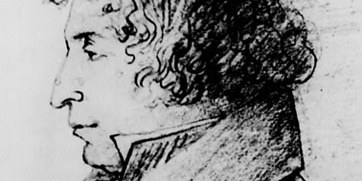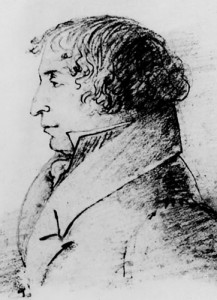Carl Niclas Keckman 1836
People who translate the Kalevala are often very diligent workers, who are driven by their passion for the language and the culture. However, they are easily almost forgotten as they are overshadowed by the great names of the authors whose works they translate. An example of this is Carl Niclas Keckman (1793–1838), who was a friend and an enthusiastic colleague of Elias Lönnrot. He was a founding member of the Finnish Literature Society and its first secretary and he was also the first university teacher of the Finnish language at the newly founded Alexander University. Keckman was born in Oulu and his mother tongue was Swedish, but he worked his whole life to make the Finnish language more widely used in the country as well as with developing the language. When the Finnish Literature Society was founded in the 1830’s the Finnish language did not even have the sufficient words, phrases and official vocabulary for writing meeting minutes, and few did know how to write in Finnish. Thus, there was a real need for developing the language.
Carl Niclas Keckman worked as Lönnrot’s unofficial editor in the 1830’s in the finalising phase of the book Kalewala, taikka wanhoja Karjalan runoja Suomen kansan muinosista ajoista (in English: Kalewala, or old poems from the Karelia from the ancient times of the Finnish people), which today is known as the Old Kalevala. Keckman did the proofreading of Lönnrot’s manuscripts, took care of practical matters with the book printing company and was, in all matters, the contact person in Helsinki for the doctor from Kajaani. The two men discussed and reflected upon matters concerning the language in their correspondence as well as when visiting each other.
When the book was published in 1835, Keckman soon started to use it in his teaching. We can assume that the majority of his students were Swedish speaking as well. For this immediate need, he translated the Kalevala word-by-word, including the foreword. Keckman’s translation was never published, but one copy of the manuscript is preserved in the manuscript archive at the University of Debrecen in Hungary. There is also a copy of this prose translation in C. N. Keckman’s own volume of the Old Kalevala, which can be found in the library of the Finnish Literature Society. According to Ferenc A. Molnár we can, therefore, presume that the first translation was finalised by the spring of 1836. It ended up in Hungary through the Hungarian translator Béla Vikár, who had translated the Kalevala into Hungarian.
The first version of Carl Niclas Keckman’s translation was also used by J. L. Runeberg, who translated about 2,5 poems of the Kalevala into Swedish. Keckman describes this process in his letter to Elias Lönnrot, dated August 5, 1835:
“[The Swedish translation of the 15th poem in the Kalevala] was done in the manner according to which I first translated it word-by-word (to the extent that I was able to), in other words, I explained it to Runeberg, who then wrote it into the form of a Swedish poem. And I did not understand it completely, which I am sure you can see in my questions; and I do not think that all the verses that I have translated into Swedish are quite correct. If you would be so kind to write down the observations and criticism that you might have about this, it would be a tremendously good thing for me.”
In his request for comments that Keckman directs to the poetry master, he refers to the translation that he has done together with Runeberg, which was published in Helsingfors Morgonblad on July 7, 1836. Lönnrot is very positive in his praise in the letter he writes to Keckman: “It does look very good and we could only hope that all the poems could be translated as beautifully as these. There might have been some mistakes, but not many.”
Keckman thought that Lönnrot himself would have been best suited for translating the Kalevala, “it is doubtful that anyone else knows the Kalevala and is able to explain it, or even understand it”, he suggests in his letter dated on May 11, 1837. The Finnish Literature Society had even reserved funding for the Swedish and German translations of the Kalevala. The funding of 500 rubels that had been granted in March 1836 for the translation apparently inspired both Runeberg and others to try and see how translating the Kalevala would turn out.
Lönnrot did not do any translations, but, on the other hand, Helsingfors Morgonblad received in October that same year a translation of the 5th poem of the Kalevala by Erik Alexander Ingman, which was published in the issues 79–80 of the newspaper. Furthermore, Carl Niclas Keckman’s stepbrother, the bishop of Härnosand, professor and esteemed poet Frans Mikael Franzén, had also translated the Kalevala. However, Franzén died in 1847 and there is no knowledge of what happened to his translated manuscript. Carl Niclas had died already in 1838, three years after the publication of the first version of the Kalevala. The correspondence between the brothers can be found in the archives of the Finnish Literature Society.
Petja Aarnipuu: “Kalevala sivistysmaan käyntikorttina” – Kalevala maailmalla. Helsinki: SKS. 2012.
Molnár, Ferenc A.: “C. N. Keckmanin Vanhan Kalevalan ruotsinnos Debrecenissä” – Kalevalaseuran vuosikirja 77–78. 1999

